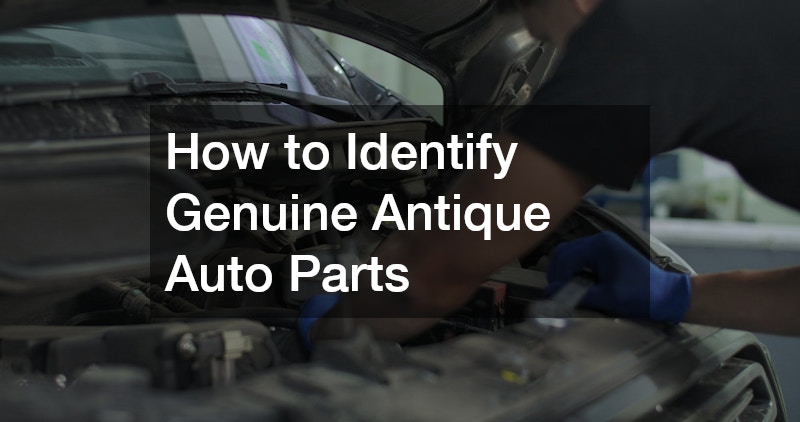Understanding how to identify genuine antique auto parts can save both time and resources while ensuring the authenticity of your restoration project. This article breaks down the essential aspects you should know. Armed with this knowledge, you’ll be well-prepared to navigate the complex world of antique auto parts and make informed decisions that enhance the value and authenticity of your projects.
The Key Characteristics of Genuine Antique Auto Parts
Material Composition
Examining the materials used in antique parts is crucial in determining authenticity. Genuine antique parts often feature materials that were prevalent in their era, such as cast iron, brass, and certain types of steel, which may differ from modern reproductions utilizing lightweight alloys or plastics.
Understanding these material differences can significantly aid in distinguishing an authentic piece from a reproduction.
In addition to the type of material, the wear and patina on the surfaces of antique parts can provide invaluable insights. Authentic parts typically show signs of aging and natural wear that are not easily replicated. Cleaning agents and polish used in modern restorations often cannot replicate the unique aging characteristics seen in genuine artifacts.
Manufacturing Techniques
Understanding historical manufacturing techniques is another vital aspect in identifying genuine antique auto parts. Techniques such as hand-forging or early casting methods leave distinct marks that differ significantly from those produced by modern machinery. These marks can act as a historical signature, verifying the piece’s authenticity.
Additionally, the precision and detail found in certain parts are indicative of the handcrafted nature of the manufacturing processes of the era. Compared to modern reproductions that often cut corners for cost and efficiency, antique parts showcase meticulous attention to detail. It’s important to note that imperfections and irregularities in genuine antique parts are often signs of human craftsmanship.
Finding Reliable Sources for Antique Auto Parts
Authorized Dealers and Auctions
When searching for genuine antique auto parts, authorized dealers and reputable auctions are among the best sources. These sellers often have a history of dealing with antique parts and can provide documentation and provenance that help verify authenticity. Dealers and auction houses adhere to industry standards and ethics, ensuring that the parts they sell maintain their historical integrity.
Some renowned auctions specialize in collector automobiles and associated parts, attracting sellers whose collections have been meticulously documented over time. Engaging with these auctions provides not only access to rare parts but also a network of knowledgeable enthusiasts and experts. These venues often feature appraisers and historians who can authenticate parts, adding another layer of assurance for buyers.
Online Platforms and Marketplaces
Navigating online marketplaces effectively is crucial for finding verified antique auto parts. Websites like eBay and specialized automotive forums offer expansive access to parts but require careful scrutiny to ensure authenticity. Utilizing buyer protection programs available on these platforms can provide an added layer of security in transactions.
Online communities dedicated to antique auto restoration often feature user reviews and peer assessments that can guide buyers towards reputable sellers. Participating in these forums allows individuals to share experiences and insights, cultivating a community-driven approach to verification. The collective knowledge of seasoned enthusiasts can aid newcomers in avoiding counterfeit items.
Verifying the Authenticity of Antique Auto Parts
Documentation and Provenance
Obtaining and assessing documentation is a critical step in verifying the authenticity of antique auto parts. Genuine parts often come with paperwork indicating their provenance, including original purchase receipts, repair records, or certificates of authenticity. Such documentation provides a historical footprint, connecting the part to its original context and ownership.
In some cases, provenance might include correspondence from the original manufacturer or previous owners, offering additional verification layers. This documentation can significantly enhance the item’s historical value and authenticity. Collectors often seek out these paper trails, as they give certainty and authority to the claims of authenticity.
Professional Appraisal
Enlisting the services of a professional appraiser is invaluable in confirming the legitimacy of antique auto parts. Professional appraisers offer an expert evaluation, backed by years of experience and a deep understanding of the industry. Their expertise often spans various brands and eras, making their assessments highly reliable.
Beyond a simple verification, appraisers often provide detailed reports that discuss the item’s condition, historical significance, and market value. This comprehensive evaluation helps both seasoned and novice collectors understand the worth and context of their acquisitions. Professional appraisal adds an authoritative voice to the authenticity of the parts, which is often essential for resale or insurance purposes.
Identifying genuine antique auto parts requires thorough research and verification. By understanding key characteristics, finding reliable sources, and verifying authenticity, you can ensure your restoration projects remain authentic and valuable. Armed with this knowledge, you can confidently navigate the world of antique auto parts and make informed decisions that uphold the integrity of your restoration endeavors.


